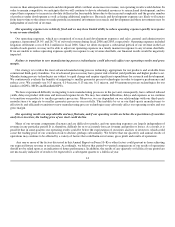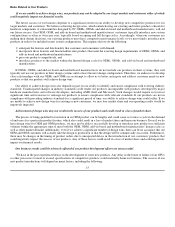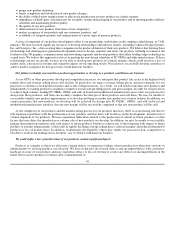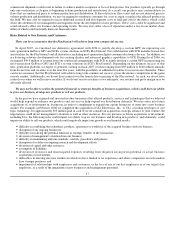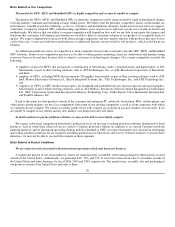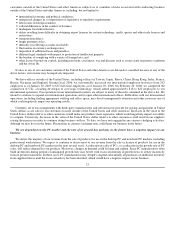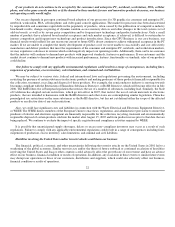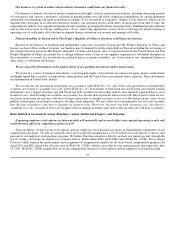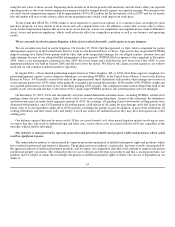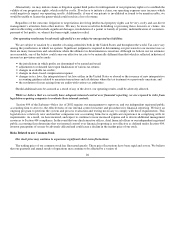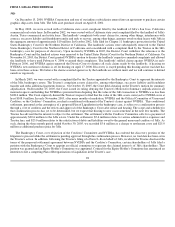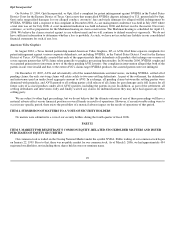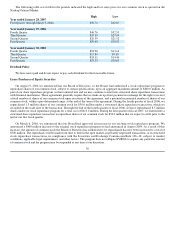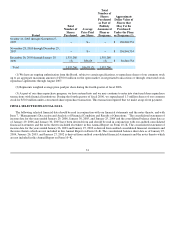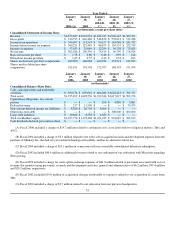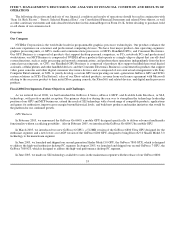NVIDIA 2006 Annual Report Download - page 29
Download and view the complete annual report
Please find page 29 of the 2006 NVIDIA annual report below. You can navigate through the pages in the report by either clicking on the pages listed below, or by using the keyword search tool below to find specific information within the annual report.
Our business is cyclical in nature and an industry downturn could harm our financial results.
Our business is directly affected by market conditions in the highly cyclical semiconductor industry, including alternating periods
of overcapacity and capacity constraints, variations in manufacturing costs and yields, significant expenditures for capital equipment
and product development and rapid technological change. If we are unable to respond to changes in our industry, which can be
unpredictable and rapid, in an efficient and timely manner, our operating results could suffer. In particular, from time to time, the
semiconductor industry has experienced significant and sometimes prolonged downturns characterized by diminished product demand
and accelerated erosion of average selling prices. If we cannot take appropriate actions such as reducing our manufacturing or
operating costs to sufficiently offset declines in demand during a downturn, our revenue and earnings will suffer.
Political instability in Taiwan and in The People's Republic of China or elsewhere could harm our business.
Because of our reliance on foundries and independent contractors located in Taiwan and The People's Republic of China, and
because we have offices in these locations, our business may be harmed by political instability in Taiwan, including the worsening of
the strained relations between The People's Republic of China and Taiwan. Also if relations between the United States and The
People's Republic of China are strained due to foreign relations events. If any of our suppliers experienced a substantial disruption in
their operations, as a result of a natural disaster, political unrest, economic instability, acts of terrorism or war, equipment failure or
other cause, it could harm our business.
We are exposed to fluctuations in the market values of our portfolio investments and in interest rates.
We invest in a variety of financial instruments, consisting principally of investments in commercial paper, money market funds
and highly liquid debt securities of corporations, municipalities and the United States government and its agencies. These investments
are denominated in United States dollars.
We account for our investment instruments in accordance with SFAS No. 115. All of the cash equivalents and marketable
securities are treated as “available−for−sale” under SFAS No. 115. Investments in both fixed rate and floating rate interest earning
instruments carry a degree of interest rate risk. Fixed rate debt securities may have their market value adversely impacted due to a rise
in interest rates, while floating rate securities may produce less income than expected if interest rates fall. Due in part to these factors,
our future investment income may fall short of expectations due to changes in interest rates or if the decline in fair value of our
publicly traded equity investments is judged to be other−than−temporary. We may suffer losses in principal if forced to sell securities
that decline in market value due to changes in interest rates. However, because our debt securities are classified as
“available−for−sale,” no gains or losses are recognized due to changes in interest rates unless such securities are sold prior to maturity.
Risks Related to Government Action, Regulatory Action, Intellectual Property, and Litigation
Expensing employee stock options in future periods will materially and aversely affect our reported operating results and
could adversely affect our competitive position as well.
Since inception, we have used stock options and our employee stock purchase program as fundamental components of our
compensation packages. To date we generally have not recognized compensation cost for employee stock options or shares sold
pursuant to our employee stock purchase program. We believe that these incentives directly motivate our employees and, through the
use of vesting, encourage our employees to remain with us. In December 2004, the FASB issued SFAS No. 123(R), Share−Based
Payment, which requires the measurement and recognition of compensation expense for all stock−based compensation payments. In
April 2005, the SEC delayed the effective date of SFAS No. 123(R), which is now effective for annual periods that begin after June
15, 2005. SFAS No. 123(R) requires that we record compensation expense for stock options and our employee stock purchase plan
23



